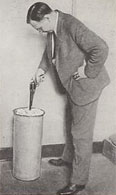- 01: Introduction
- 02: History
- 03: Propellants, Firearms, and Ammunition Development
- 04: Modern Firearms Manufacture
- 05: Small Arms Ammunition
- 06: Evidence Handling Procedures
- 07: Equipment and Instrumentation
- 08: Examination of Firearms
- 09: Cartridge and Shotshell Examination
- 10: Characterization and Evaluation of Fired Projectiles
- 11: Bullet Comparison and Identification
- 12: Gunshot Residue and Distance Determination
- 13: Toolmark Identification
- 14: Communicating Results
- Resources


1940-1950
Home > History > 1940-1950
1940-1947

Calvin Goddard firing pistol
for bullet recovery
A number of state and municipal crime laboratories were established across the United States, with forensic disciplines that included firearm and toolmark examination.
Laboratories established during this time included
- the first criminology laboratory established in Oakland, California,
- the Indianapolis Police Department (IPD), a fully equipped crime laboratory under the direction of a trained scientist,
- the first state crime laboratory in Wisconsin, supervised by Charles M. Wilson, who was associated with Goddard at the SCDL at Northwestern and who later became the director of the Chicago Police Department Crime Laboratory.
1948
The First American Medicolegal Congress meeting was held in St. Louis, Missouri.
Two papers were presented at the initial meeting concerning firearms identification:
- "Firearms Evidence — Fact and Fiction," presented by George W. Keenan, Department of Public Safety, Rochester, New York
- "The Recovery, Custody, Marking, and Preservation of Physical Evidence and Standards of Comparison Including Firearms Exhibits," presented by Charles M. Wilson, of the Wisconsin State Crime Laboratory, Madison, Wisconsin
1949
Colonel Calvin H. Goddard became the commanding officer of the U.S. Army Criminal Investigation Laboratory – Far East (Tokyo, Japan). He was instrumental in training examiners within the U.S. Army Laboratory System until his retirement from the service.
1950
In response to interest generated during the 1948 First American Medicolegal Congress meeting, the American Academy of Forensic Sciences (AAFS) was formally established and began publication of the Journal of Forensic Science (JFS).




